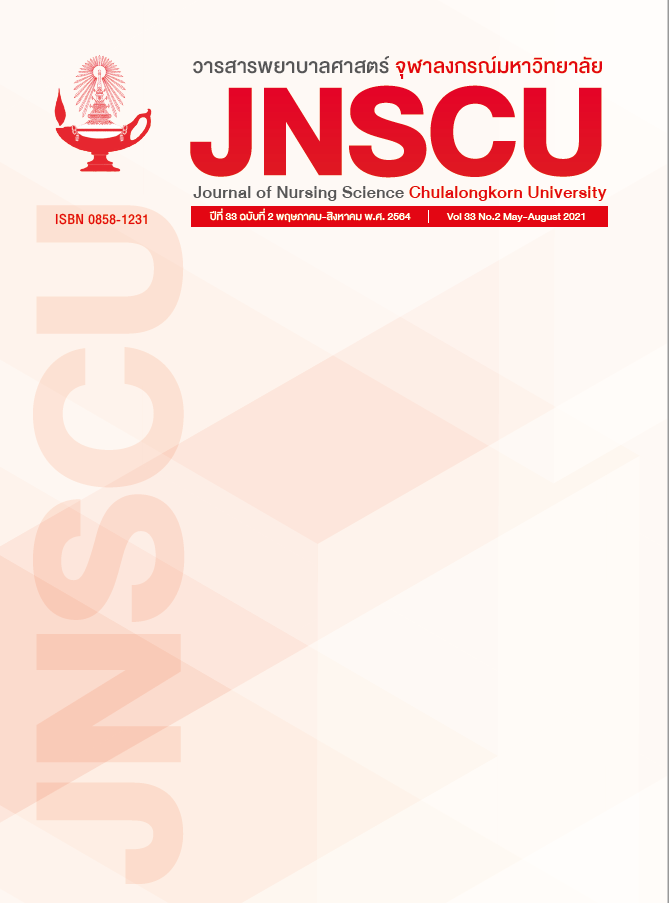The Effects of a Family Participation Program Regarding Sensory Stimulation on the Brain Recovery among Patients with Severe Traumatic Brain Injury
Keywords:
A family participation program, Sensory stimulation, Brain recovery, Severe traumatic brain injuryAbstract
Purpose: The study aimed at examining the effects of family participation in sensory stimulation programs on brain recovery among patients with severe traumatic brain injury.
Design: Quasi-experimental research, one group design.
Methods: This study used Schepp and Pai’s family participation framework and Sosnowski and Ustik’s theory as a framework. The sample consisted of 26 patients with severe traumatic brain injury in one hospital in the eastern part of Thailand. This program included providing information, practicing skills, and enhancing the family to participate in sensory stimulation for 14 days. The instruments were composed of 1) demographic questionnaire 2) Glasgow coma scale 3) the sensory stimulation promoting program 4) a caregiver manual for caring patients with severe traumatic brain injury, 5) Rancho Los Amigos Score and 6) SMART assessment form. All research instruments had content validity. The Cronbach’s alpha coefficient of reliability for the questionnaire was .80. Data were analyzed by using descriptive statistics, repeated measures ANOVA and the Wilcoxon-Mann-Whitney test.
Finding: the experimental group had a significantly greater mean score of brain recovery on days 7 and 14 after receiving the program than before receiving the program (p<.01).
References
Saksirisamphan B. Epidemiological surveilance
report 2015: Severe injury due to
transport accidents [Internet]. 2015
[cited 2017 Jan 1]. Available from:
https://appsdoe.moph.go.th/boeeng/
annual/Annual/AESR2015/aesr2558/
Part%201/10/transport_accidents.pdf
Thai RSC. Report using statistics Act [Internet].
[cited 2016 Jan 1]. Available from:
rvreport.rvperservice.com/viewersc.
aspx?report=0475&session=16
Porth CM. Essentials of pathophysiology:
concepts of altered health states.
New York: Lippincott Williams & Wilkins;
Auantri P. The effect of familiar voice to
auditory stimulation on level of
conscious and behavioral response of
auditory in head injury patients with
unscious [Unpublished master’s thesis].
Khon Kaen: Khon Kaen University; 2002.
Sosnowski C, Ustik M. Early intervention:
coma stimulation in the intensive care
unit. J Neurosci Nurs 1994; 26(6): 336-41.
Kaewsriwong S, Sukonthasarn A, Wangsrikhun
S, Chanprasit C. Sensory stimulation
process and cognitive function among
persons with traumatic brain injury:
a case study. Pacific Rim Int J Nurs Res
: 19(1); 45-57. (in Thai)
Moattari M, Shirazi FA, Sharifi N, Zareh N.
Effects of a sensory stimulation by
nurses and families on level of cognitive
function, and basic cognitive sensory
recovery of comatose patients with
severe traumatic brain injury: a
randomized control trial. Trauma Mon
; 21(4): e23531. Doi: 10.5812/
traumamon.23531.
Schepp K, Pai J. Psychometric assessment
of the preferred participation scale
for parent of hospitalized children.
Washington, D.C.: University of
Washington; 1995.
Helwich LD. Stimulation program for coma
patients. Crit Care Nurse 1994; 14(4):
-52.
Chaiwang S, Sukonthasarn A, Tungamnuay
T. Effect of sensory stimulation on
cognitive-behavioral responses of
traumatic brain injuried persons. JTNMC
; 22(1): 48-59. (in Thai)
Teasdale G, Jennett B. Assessment of coma
and impaired consciousness: a practical
scale. Lancet 1974; 304(7872): 81-4.
Silarium L, Harnirattisai T, Muengtaweepungsa
S. The effects of a family participation
in rehabilitation program on swallowing
and eating ability among acute stroke
patients. Nurs J 2014; 41 (Suppl): 180-91.
(in Thai)
Urbenjaphol P. Cognitive function recovery
of traumatic brain injury patients by
sensory stimulation. TRCN J 2015; 8(1):
-62. (in Thai)
Levy DE, Bates D, Coronna JJ, Cartledge N,
Knill-Jones R, Lapinski RH, et al. Prognosis
in non-traumatic coma. Ann Intern Med
; 94(3): 293-301. Doi: 10.7326/0003-
-94-3-293.
Downloads
Published
Issue
Section
License

This work is licensed under a Creative Commons Attribution-NonCommercial-NoDerivatives 4.0 International License.
ลิขสิทธิ์ของบทความที่ตีพิมพ์เป็นของวารสารพยาบาลศาสตร์ จุฬาลงกรณ์มหาวิทยาลัย ทั้งฉบับตีพิมพ์เป็นรูปเล่มและเอกสารออนไลน์

